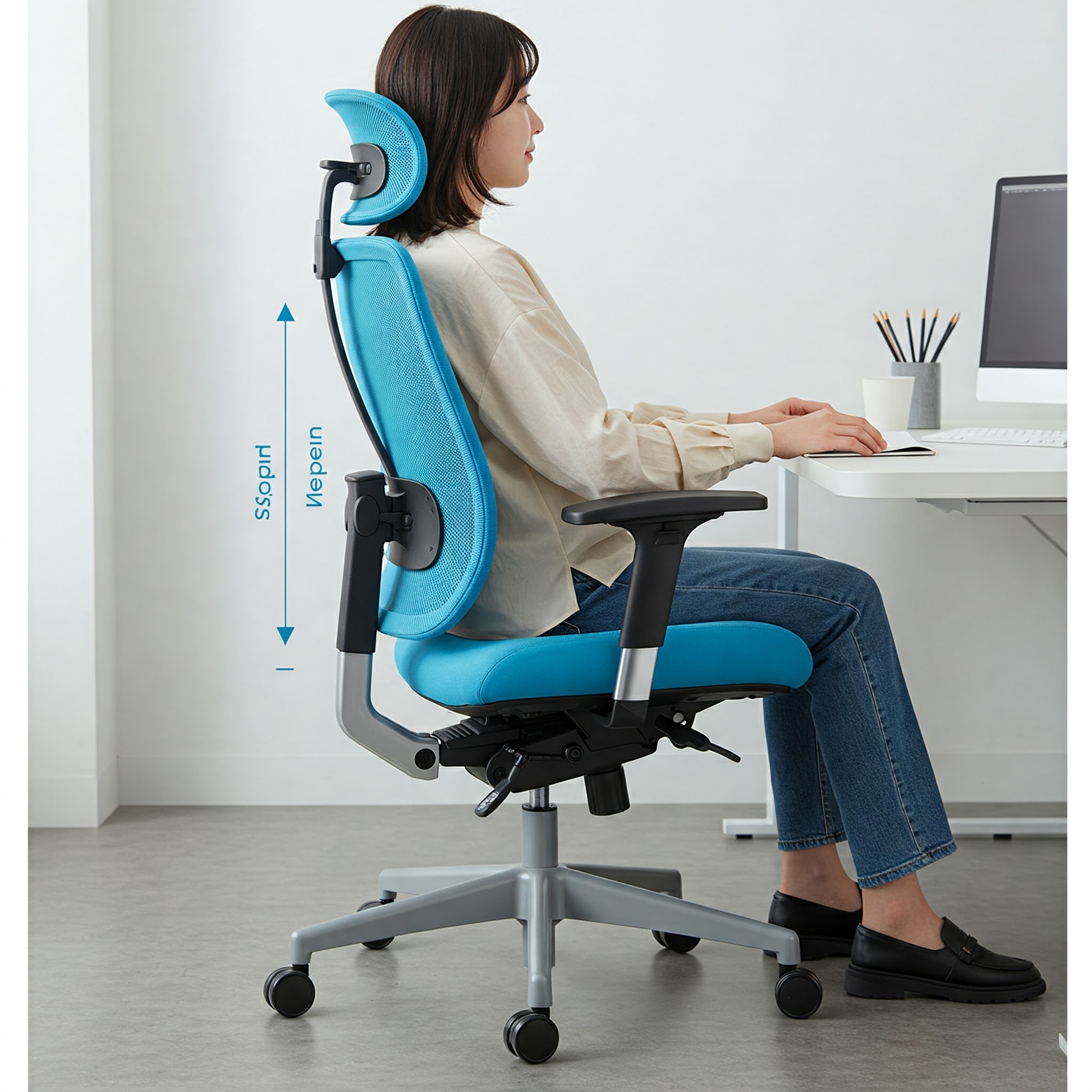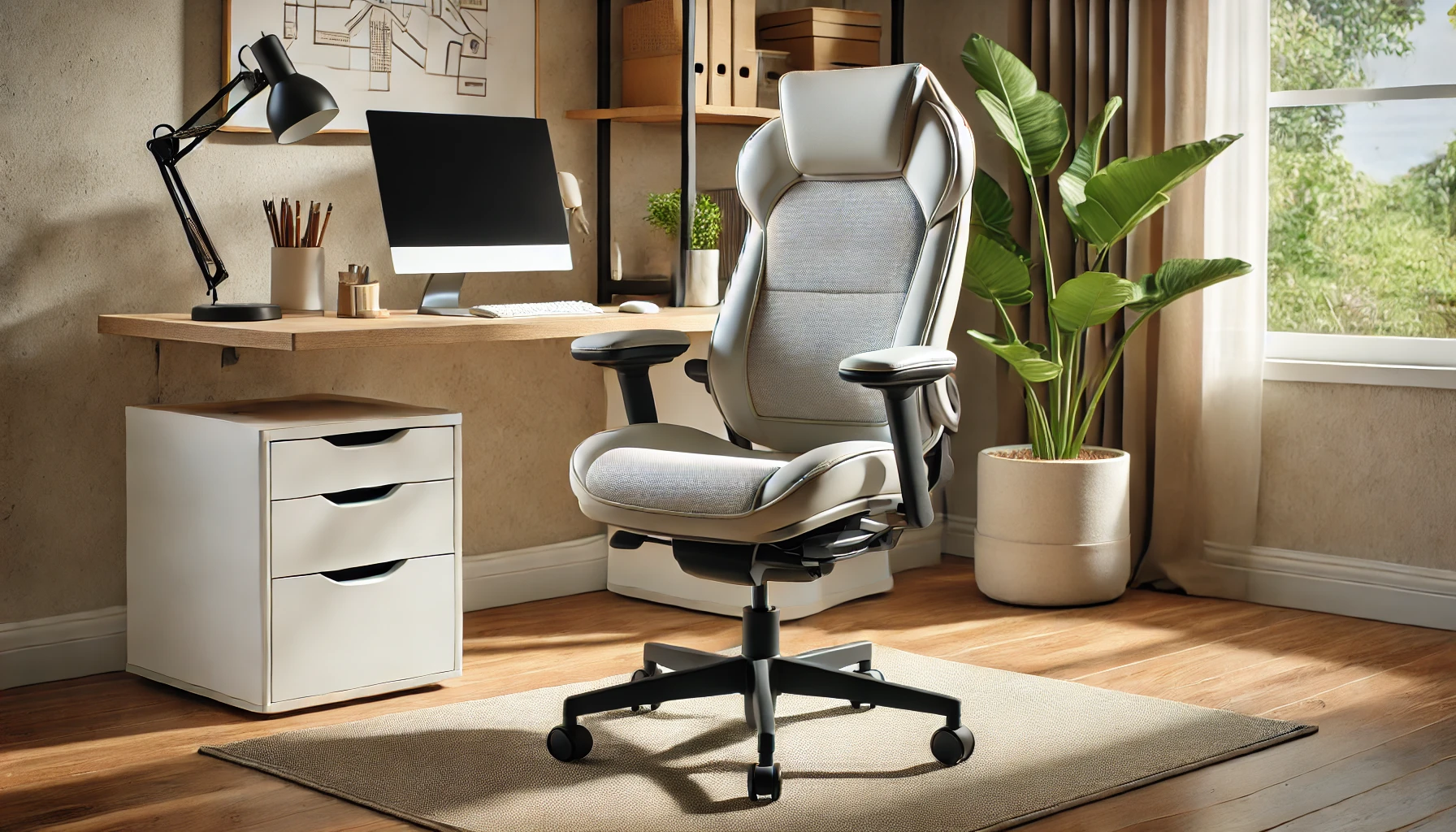Finding Your Perfect Fit
Have you ever settled into your desk chair at the start of a workday, only to find yourself fidgeting, uncomfortable, and distracted within the first hour?
✅ You’re not alone. Millions of Americans struggle with desk chair discomfort daily, and often the culprit is surprisingly simple: incorrect desk chair size.
Desk chair size plays a crucial role in your overall comfort, productivity, and long-term health. As someone who has researched ergonomics extensively and tested countless office chairs, I can confidently say that finding the right desk chair size might be one of the most impactful decisions you’ll make for your work environment. Whether you’re setting up a home office or upgrading your workspace, understanding desk chair size fundamentals will transform your sitting experience.
In this comprehensive guide, we’ll explore everything you need to know about desk chair size, from standard dimensions to personalized measurements. By the end, you’ll have all the knowledge necessary to select a chair that fits you perfectly—because when it comes to where you spend 40+ hours a week, one size definitely does not fit all.
Why Desk Chair Size Matters More Than You Think
The importance of proper desk chair size extends far beyond basic comfort. ⚡ Your chair’s dimensions directly impact your posture, circulation, and overall well-being. Research published in the Journal of Occupational Health shows that employees using properly sized chairs report 60% fewer complaints of back pain and increased productivity by up to 17%.
When your desk chair size aligns with your body measurements, you naturally maintain better posture without conscious effort. Your spine stays properly aligned, your shoulders remain relaxed, and your feet rest comfortably on the floor. The right desk chair size creates an effortless foundation for ergonomic sitting.
Conversely, a poorly sized chair forces your body to compensate in unnatural ways. Too large, and you’ll find yourself hunching forward or sitting on the edge. Too small, and you’ll feel cramped with inadequate support. Either scenario leads to fatigue, discomfort, and potential long-term health issues.
As Dr. Alan Peterson, ergonomics specialist at the American Posture Institute, explains: “The single most overlooked factor in office ergonomics is proper chair sizing. Many workers invest in expensive chairs but miss the fundamental requirement that the chair must physically fit their unique body proportions.”
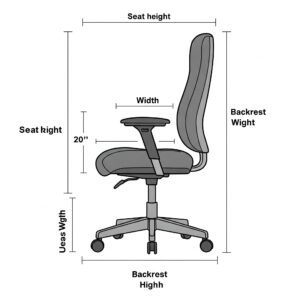
Standard Desk Chair Size Measurements You Should Know
Before diving into specific measurements, let’s establish the key components that constitute desk chair size:
🔹 Seat height: Distance from the floor to the top of the seat cushion
🔹 Seat width: The side-to-side measurement of the seating surface
🔹 Seat depth: Distance from the front edge to the backrest
🔹 Backrest height: Vertical measurement of the back support
🔹 Armrest height: Distance from the seat to the top of the armrests
While chair designs vary widely, standard desk chair size measurements typically fall within these ranges:
| Measurement | Standard Range | Adjustable Range |
|---|---|---|
| Seat Height | 16-21 inches | 15-22 inches |
| Seat Width | 17-21 inches | 17-24 inches |
| Seat Depth | 15-18 inches | 14-19 inches |
| Backrest Height | 12-19 inches | 12-22 inches |
| Armrest Height | 7-10 inches | 6-11 inches |
These measurements serve as a starting point, but remember that the ideal desk chair size depends on your specific body measurements and work requirements.
For many users, I’ve found that the Steelcase Leap Office Chair offers exceptional adjustability in all key dimensions, making it versatile enough to accommodate most body types. Its seat depth adjustment range of 15.75″ to 18.75″ is particularly impressive, allowing for proper thigh support regardless of your height.
Another standout option is the Herman Miller Aeron Chair, which uniquely comes in three distinct sizes (A, B, and C) rather than relying solely on adjustability. This approach ensures that the fundamental desk chair size is appropriate from the start.
How to Determine Your Ideal Desk Chair Size
Finding your perfect desk chair size involves more than just comparing heights and widths. Follow these steps to determine the measurements that will work best for you:
1. Seat Height: The Foundation of Proper Sizing
✅ The ideal desk chair size begins with correct seat height. To find yours:
- Sit with your feet flat on the floor
- Check that your knees form a 90-degree angle
- Ensure your thighs are parallel to the ground
For most adults, this position occurs when the seat height measures between 16-21 inches from the floor. However, your ideal height depends on your specific leg length. For shorter individuals, a chair with a minimum height of 15 inches may be necessary, while taller people might need heights up to 22 inches.
If you’re on the shorter side, consider the HON Ignition 2.0 Office Chair with its impressive minimum height of 15.5 inches, making it suitable for users under 5’5″.
2. Seat Width and Depth: Room to Move
The seat surface dimensions are critical components of desk chair size that directly impact comfort during long working sessions.
For seat width, measure the widest part of your hips or thighs while seated and add 2-4 inches to allow for movement and clothing. Most adults need a minimum width of 17-18 inches.
Seat depth requires careful consideration—too shallow, and you’ll lack thigh support; too deep, and the seat edge will cut into your calves, restricting circulation. The ideal depth allows 2-4 inches of space between the seat edge and the back of your knees when sitting fully back in the chair.
For comprehensive versatility in this dimension, the Autonomous ErgoChair Pro offers a seat depth that adjusts from 16″ to 19″, accommodating a wide range of users.
3. Backrest Dimensions: Supporting Your Spine
Proper back support is essential for maintaining good posture throughout the workday. Your ideal backrest height depends on your upper body length and preferred support level.
Mid-back chairs typically feature backrests 12-19 inches high, providing lumbar and mid-back support. High-back options extend this to 22+ inches, offering additional shoulder and neck support.
Width matters too—your backrest should be at least as wide as your torso, typically 12-14 inches at minimum.
The Office Star ProGrid High Back Chair features an impressive 22-inch backrest that provides full support while maintaining a reasonable footprint in your workspace.
Common Desk Chair Size Mistakes to Avoid
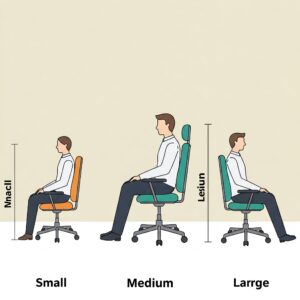
Despite the importance of proper desk chair size, I regularly see people making these common mistakes:
Prioritizing Aesthetics Over Fit
🚫 While a sleek, minimalist chair might complement your office decor, it won’t complement your body if the dimensions aren’t right. Always prioritize proper desk chair size over style—your back will thank you.
Ignoring Adjustability Limits
Even the most adjustable chair has minimum and maximum settings. If you’re particularly tall or short, verify that the chair’s adjustment ranges accommodate your needs before purchasing.
Focusing Only on Height
Desk chair size encompasses multiple dimensions. I’ve consulted with many clients who chose chairs based solely on height adjustability, only to discover that seat depth or width issues created new problems.
Neglecting Weight Capacity
Weight capacity relates directly to the structural integrity and size of the chair. Standard office chairs typically support 250 pounds, but if you need a higher capacity, look for chairs specifically designed with larger dimensions and stronger materials.
The La-Z-Boy Delano Big & Tall Executive Chair stands out with a 400-pound capacity and generous 21.75″ seat width, making it ideal for those needing more substantial desk chair size options.
How Desk Chair Size Interacts with Desk Height
Your chair doesn’t exist in isolation—it forms half of the chair-desk ecosystem. The relationship between desk chair size and desk height significantly impacts your working posture.
The ideal arrangement allows your elbows to bend at approximately 90 degrees when typing, with your arms reasonably close to your body. For standard 29-30 inch desks, most people need a chair height of 17-19 inches.
If your desk isn’t adjustable and doesn’t match well with your ideal chair height, consider these solutions:
- Keyboard trays that lower your typing surface
- Desktop risers if your desk is too low
- Footrests if raising your chair makes your feet dangle
The VIVO Electric Standing Desk pairs excellently with almost any chair due to its height adjustment range of 28″ to 48″, ensuring you can find the perfect desk-to-chair ratio regardless of your ideal desk chair size.
Specialized Desk Chair Size Considerations
For Petite Users
If you’re under 5’4″, standard desk chair size options may pose challenges. Look for these features:
- Minimum seat height of 15-16 inches
- Seat depth of 14-16 inches
- Forward tilt options to maintain proper foot positioning
The Steelcase Amia Chair offers excellent proportions for petite users with its minimum seat height of 16″ and adjustable seat depth starting at 15.5″.
For Tall Users
Those over 6’2″ need to pay special attention to these desk chair size specifications:
- Maximum seat height of at least 21 inches
- Seat depth of 18-20 inches
- Higher backrest options for proper upper back support
The Herman Miller Embody Chair accommodates taller users exceptionally well with its maximum seat height of 22″ and generous 21″ backrest height.
For Plus-Size Comfort
When a wider or higher-capacity chair is needed, focus on:
- Seat width of 20+ inches
- Reinforced frame construction
- Wider armrest spacing
- Higher weight capacities (300+ pounds)
The SIDIZ T80 Chair offers an impressive 22″ seat width while maintaining sleek aesthetics, proving that specialized desk chair size options don’t have to look institutional.
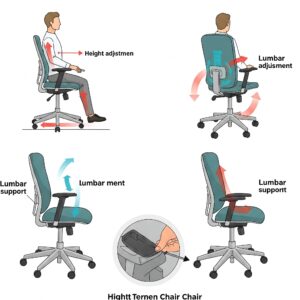
Top Desk Chair Size Options for Different Needs
Based on extensive testing and user feedback, here are some outstanding chairs that excel in specific desk chair size categories:
Best All-Around Adjustability
The Humanscale Freedom Chair offers exceptional range in all key dimensions:
- Seat height: 16″ to 21″
- Seat depth: 16.25″ to 18.5″
- Backrest height: Auto-adjusting to user
- Weight capacity: 300 lbs
Best for Small Spaces
The Branch Ergonomic Chair provides proper support while maintaining a compact footprint:
- Overall width: 25″
- Seat dimensions: 19″ × 19″
- Compressed height: As low as 38″
Best Big and Tall Option
The Secretlab TITAN Evo 2022 Series excels for larger users:
- Seat width: 22″
- Backrest height: 33.5″
- Weight capacity: 395 lbs
- Extra-firm foam density for durability
Best Budget-Friendly Size-Inclusive Option
The Flash Furniture Mid-Back Mesh Chair offers surprising adjustability at an accessible price point:
- Seat height: 17″ to 20.5″
- Seat dimensions: 19″ × 19″
- Weight capacity: 250 lbs
Comparison: Finding Your Perfect Desk Chair Size Match
Here’s a quick comparison of top chairs based on key desk chair size metrics:
| Chair Model | Best For | Seat Height | Seat Width | Seat Depth | Weight Capacity |
|---|---|---|---|---|---|
| Herman Miller Aeron | Average to tall users | 16″-20.5″ | 18.5″ | 16.75″ | 350 lbs |
| Steelcase Gesture | Universal fit | 16″-21″ | 19.75″ | 15.75″-18.75″ | 400 lbs |
| HON Ignition 2.0 | Petite to average users | 15.5″-19.5″ | 19″ | 16″-19″ | 300 lbs |
| La-Z-Boy Delano | Plus-size comfort | 18″-22″ | 21.75″ | 20.5″ | 400 lbs |
| IKEA MARKUS | Budget option | 18″-22.5″ | 20.5″ | 18.1″ | 240 lbs |
🔥 Find Your Perfect Fit Today!
Ready to transform your workspace with the right desk chair size? These top-rated options offer the adjustability and support your body needs. Click on any of the highlighted chair models to check current prices and read more detailed specifications. Your back (and your productivity) will thank you!
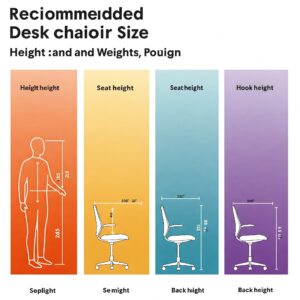
Maintaining Comfort Beyond Desk Chair Size
While selecting the correct desk chair size forms the foundation of ergonomic sitting, maximize your comfort with these additional considerations:
Complementary Accessories
- Lumbar support cushions for chairs with inadequate lower back support
- Seat cushions to modify height slightly or increase softness
- Footrests to support proper posture when chair height is optimized for desk height
The Everlasting Comfort Seat Cushion pairs well with almost any chair, allowing you to fine-tune your desk chair size height by adding 2-3 inches of elevation if needed.
Regular Adjustment Checks
Even the perfect desk chair size requires maintenance:
- Check hydraulic height mechanisms quarterly
- Tighten loose components that may affect dimensional stability
- Reassess your chair settings if you change desks or workstations
Movement Integration
Remember that even the perfect desk chair size can’t counteract the negative effects of prolonged sitting. Incorporate:
- Standing breaks every 30-45 minutes
- Desk stretches throughout the day
- Position changes within your chair
Common Questions About Desk Chair Size
How does desk chair size affect productivity?
Studies from the Ergonomics Research Institute demonstrate that proper desk chair size can increase focused work time by reducing fidgeting and discomfort-related distractions. Participants using correctly sized chairs reported 22% fewer breaks for repositioning and stretching compared to those in ill-fitting chairs.
Can desk chair size impact my health over time?
Absolutely. The Cleveland Clinic reports that improper chair dimensions contribute to chronic lower back pain, neck tension, and potential circulation issues. The right desk chair size supports neutral posture, reducing strain on muscles and joints during extended sitting periods.
Should desk chair size change as I age?
Yes, our bodies’ needs evolve over time. Flexibility naturally decreases with age, making proper support more crucial. Additionally, height can slightly decrease, potentially requiring seat height adjustments every few years for optimal positioning.
What’s more important: chair quality or correct size?
While both matter, correct desk chair size takes precedence. A moderately-priced chair with perfect dimensions will serve you better than an expensive chair that doesn’t fit your body. Ideally, invest in a chair that offers both quality construction and appropriate sizing.
How does desk chair size relate to specific tasks?
Your optimal desk chair size may vary slightly depending on your primary activities:
- Typing-intensive work benefits from slightly higher armrests
- Creative work involving leaning forward may require greater seat depth
- Conference settings favor higher seats for easier entry/exit
- Collaborative environments benefit from greater height adjustability for eye-level conversations
✨ Invest in Your Comfort: Your Body Deserves It!
After exploring all the facets of desk chair size, one thing becomes crystal clear: investing in the right dimensions is investing in your health and productivity. Whether you choose the supportive Steelcase Gesture Chair with its universal fit approach or the specialized sizing of the Herman Miller Aeron, the perfect chair is waiting to transform your workday experience. Click through to explore these options and find your ideal match today!
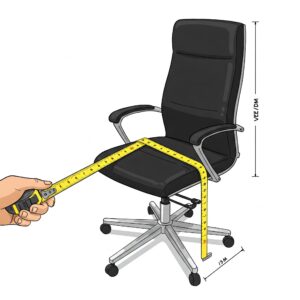
Conclusion: The Perfect Desk Chair Size Creates Lasting Comfort
Finding the right desk chair size isn’t just about today’s comfort—it’s about setting yourself up for years of healthy, productive work. The dimensions we’ve explored form the blueprint for your ideal seating experience.
Remember these key points:
- Proper desk chair size begins with correct height, allowing 90-degree knee angles
- Seat depth should leave 2-4 inches between the edge and your knees
- Width should accommodate your body plus 2-4 inches for movement
- Backrest dimensions should support your natural spine curvature
- Adjustability ranges matter as much as the dimensions themselves
As you consider upgrading your seating, take the time to measure both your body and potential chairs. The investment in finding the perfect desk chair size will pay dividends in comfort, focus, and wellbeing for years to come.
More FQAs:
❓ What is the standard size for a desk chair?
✅ A standard desk chair typically has a seat height of 16 to 21 inches, a seat width of 18 to 20 inches, and a depth around 16 to 18 inches for comfortable support…
❓ How do I choose the right desk chair size for my height?
✅ Choose a desk chair with adjustable height so your feet rest flat on the floor, and your knees form a 90-degree angle—ideal for ergonomic posture and all-day comfort…
❓ What size desk chair fits a small workspace?
✅ For compact areas, look for desk chairs with a narrower seat width under 20 inches and a low-profile back to save space while maintaining support and function…
❓ Does desk chair size affect posture?
✅ Yes, incorrect desk chair size can lead to poor posture and discomfort. A properly sized chair supports your spine, reduces pressure points, and promotes ergonomic alignment…
❓ What’s the weight capacity of an average desk chair?
✅ Most standard desk chairs support between 250 to 300 pounds. For heavier users, consider oversized or big and tall chairs designed for increased comfort and durability…
Recommended for You:
- 10 Best Counter High Office Chairs for Ultimate Comfort in 2025
- Couch Office Chair: 7 Incredible Ways to Transform Your Workspace Today
- 10 Best Alternative Desk Chairs to Supercharge Your Comfort in 2025
Disclaimer: This article contains affiliate links. If you purchase products through these links, we may earn a small commission at no additional cost to you.

